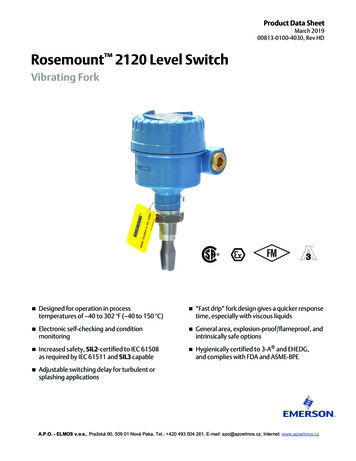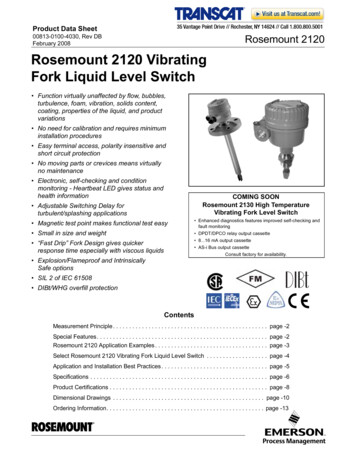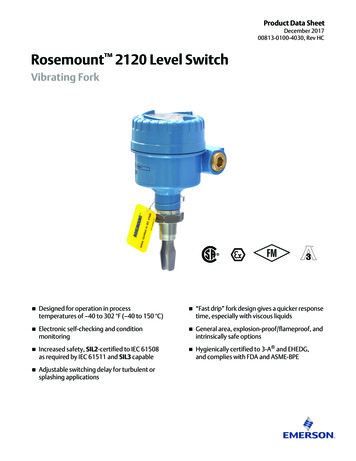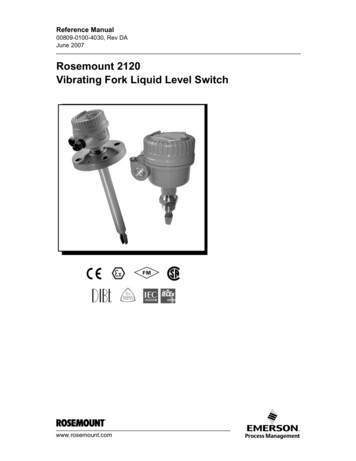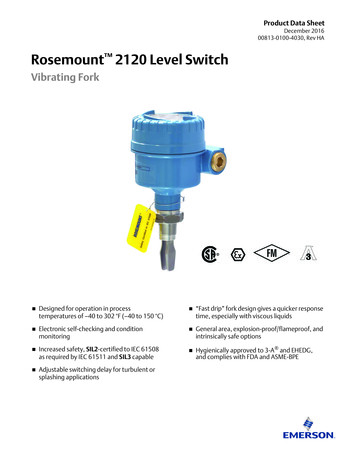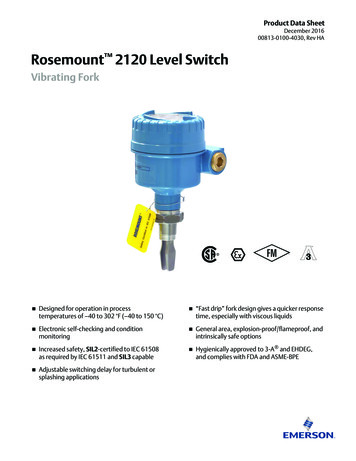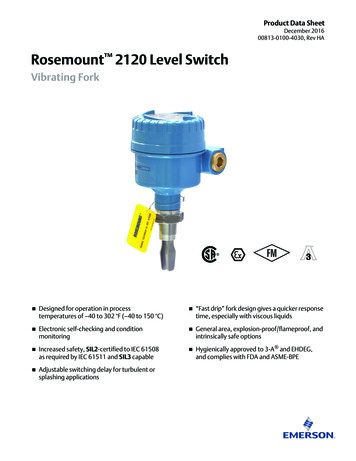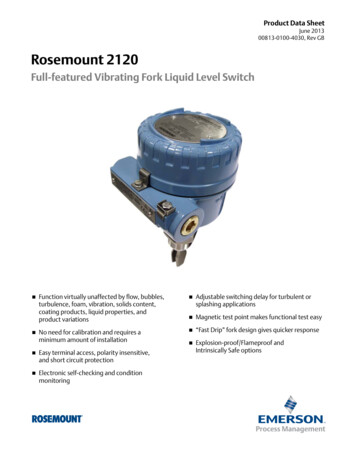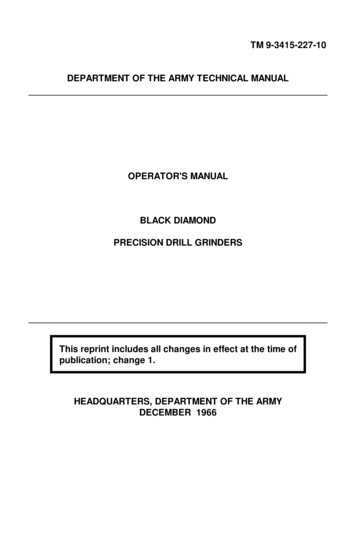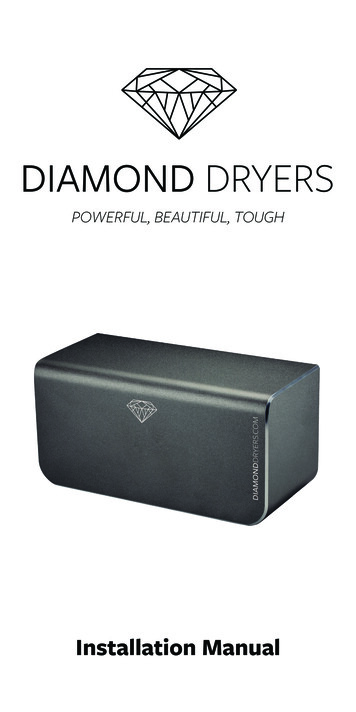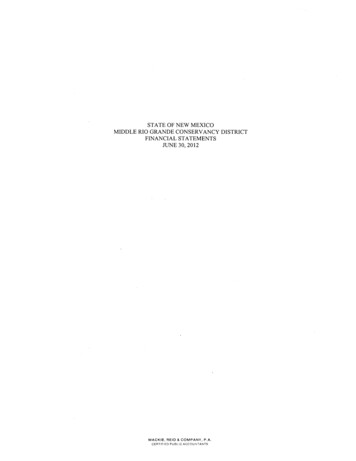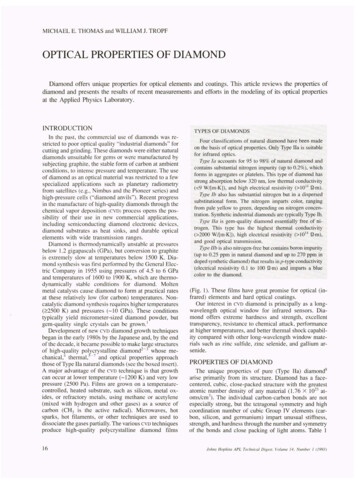
Transcription
ENVIRONMENTAL HEALTH DIVISION2120 Diamond Blvd., Suite 100Concord, CA 94520Phone: (925) 608-5500Fax: (925) 608-5502www.cchealth.org/ehMECHANICAL VENTILATION FOR COOKING EQUIPMENTMechanical Ventilation System Sample DiagramGeneralProper ventilation of cooking equipment provides for employee comfort; protects equipment,finishes, and food from excess heat or moisture, which can cause their deterioration; and removesmoisture and grease which can encourage insect infestations and result in slip and fall injuries.Where large amounts of grease vapors are produced, the mechanical ventilation system serves toremove grease from the air stream preventing its accumulation in the duct system. This reducesthe risk of grease fires.Mechanical ventilation hood systems are required above all high-temperature dishwashingmachines (except under-counter models) and cooking equipment, including ranges, griddles,broilers, steam jacketed kettles, ovens, large popcorn machines, deep fryers, barbecues,rotisseries, and any equipment that produces cooking odors, steam, grease, heat, or vapors.Requirements for mechanical ventilation systems include:
Ventilation systems must be constructed and installed in accordance with the locallyadopted Uniform Mechanical Code (UMC). Joints and seams are to be tightly sealed and easily cleanable. Riveted seams are notacceptable. Any penetrations of the hood canopy or duct must be done using UL-listed materials andmethods. Grease troughs not associated with the filter bank are not recommended, but whenprovided they must slope to an approved drip pan. Grease troughs and drip pans must beeasily cleanable. Food heating or warming devices (e.g., cheese-melters, plate warmers) and shelving thatare installed above other equipment beneath an exhaust hood may create an air flowobstruction to the proper ventilation of the cooking equipment for which the hood wasdesigned. The installation of these devices is subject to evaluation and approval, and mustbe considered as part of the ventilation design. Hoods less than one foot from walls or ceilings must be flashed solidly with approvedmaterials. Ventilation must be to the outside (e.g., no “ventless” or “ductless” hoods).Hood MaterialsHoods constructed of stainless steel must have a thickness of No. 22 gauge. If copper is used, thecopper sheet is to have a weight of at least 24 ounces per square foot. Galvanized or paintedmaterials are not acceptable hood materials.Canopy-type HoodsThe lower lip of canopy-type hoods must be no more than 4 feet above cooking surfaces and atleast 6½ feet above the floor. The hood must overhang or extend a horizontal distance not lessthan 6-inches beyond the outer edges of cooking surfaces on all open sides as measured from theinside edge of the hood. Greater than 6-inch overhang is often required depending on the type ofequipment used. For example, some ovens may require a 3 foot overhang; char broilers require atleast a 12-inch overhang. See the handout, Requirements for Hood Plans, for specific overhangrequirements.Non-canopy-type (Ventilator) HoodsNon-canopy hoods may be approved if they are engineered and constructed so as to comply withthe minimum exhaust air velocity requirements and comply with manufacturers specifications.Shielding at the ends of the hood may be necessary to prevent interference from cross drafts.These types of hoods are not suitable for certain types of cooking equipment such as char broilers,ovens, or ranges.
Make-up AirFiltered make-up air must be provided at least equal to that amount which is mechanicallyexhausted. For example, a hood exhaust system drawing 3000 cubic feet of air per minute (cfm)must have a make-up air source providing 3000 cfm. Windows and doors are not to be used for thepurpose of providing make-up air. The location and design of make-up air diffusers must also takeinto account preventing cross-drafts or other interferences with the hood operation. A singleinterlocking switch is required for operating the hood exhaust and its make-up air source.Make-up air diffusers must facilitate the functioning of the exhaust hood system. Four-way diffusersare not allowed less than 10 feet from any hood system unless the air stream does not blowdirectly toward the hood. It is recommended that diffusers closer than 10 feet from hood systemsbe the perforated type.Short-circuiting Hood SystemsShort-circuiting hood systems or other types where the make-up air discharges inside the hoodcanopy or “capture zone” will not be approved.Fire Extinguishing SystemsFire extinguishing systems may be required by local fire or building departments. They must beinstalled so as to allow easy cleaning of the hood and duct systems. Horizontal piping or conduitwithin the hood is prohibited.The fire department may have requirements for the minimum separation between deep fatfryers and open-flame cooking equipment.Grease Filters/Extractors for Type I HoodsHoods with grease filters are required to use baffle-type filters with the baffle slats orientedperpendicular to the floor. Mesh-type filters are not allowed. Filter handles are required for hoodswith grease filters unless the filters are designed for in-place cleaning. Other types of greaseremoval systems will be evaluated on a case-by-case basis. Other requirements include: The distance between the bottom edge of the filter and the cooking surface must be at least2 feet, except for exposed fire or charcoal char broilers where the minimum distance mustbe 3½ feet. Baffle filters must be installed at an angle of 45-90 degrees from the horizontal. Hoods must provide air velocity in the range of the filter’s rated capacity. The allowablerange is typically 250-350 feet per minute (fpm) with 300 fpm the recommended velocity formost filters. Other proposed velocities will be evaluated on a case-by-case basis. Grease filters must always be in place and the fire suppression system fully functionalwhen cooking equipment is turned on.
DuctsDucts for Type I hoods must be sized so the velocity of exhausted air is no greater than 2500 fpm.There must be at least one duct per 12 lineal feet of hood length, or fraction thereof. For example,a 14 foot long hood would be required to have at least 2 ducts. Ducts must terminate outside thebuilding in an approved manner. Ductless/ventless hood systems are not allowed.Caster and Quick-DisconnectsHeavy Duty Quick-DisconnectFlexible Gas Line with Keeper ChainIf allowed by the local fire department, it is recommended that approved 6-inch high casters withapproved tether devices be provided for cooking equipment to facilitate cleaning operations. Whencasters are used, approved heavy-duty, quick-disconnect, flexible gas lines must be provided.Casters must allow for ready inspection and maintenance operations. If casters are not intendedfor use, detail the means for installing equipment that will allow for ease of inspection andmaintenance.Wood Burning OvensWood burning ovens require a separate ventilation system with a Type I canopy hood. The hoodmust overhang the front of the oven at least 18-inches and sides of the door at least 6 inches. Theminimum distance from the top of the oven-duct to the filter is to be at least 12-inches.Multiple-Stack Conveyor-type Ovens
For multiple-stack conveyor-type ovens, the hood must overhang the conveyor belt apparatus atleast 6-inches. The hood must overhang the oven openings and side doors by at least 12-inches.Conveyor-type DishwashersIf pant-leg hoods are to be used for conveyor-type dishwashers, the hood overhang at the dirtydish end must be at least 6-inches with an exhaust rate of at least 300 cfm, and at the clean dishend at least 10-inches with an exhaust rate of at least 500 cfm.Hood OverhangIn designing hoods with at least the minimum required overhang, take into account not only theactual size of the equipment under the hood, but also cleaning and installation requirements of theequipment (i.e., piping, gas lines, quick-disconnect lines, valves, wiring, etc.) which may make theeffective size of equipment greater than the dimensions specified by the manufacturer.Minimum hood overhangs range from 6-inches up to several feet depending on the type ofequipment. See the handout, Requirements for Hood Plans, for complete details on hoodoverhang requirements. In general, increasing hood overhang improves hood performance.ClearancesUnless on casters, provide at least 6-inches of clearance between pieces of equipment under thehood and between the equipment and walls. When sizing hood overhang, take these clearancesinto consideration so the minimum overhang requirements will be met. Reduced clearances maybe allowed if adequate methods for cleaning and inspection are provided (e.g., casters).UL Listed HoodsIf the hood system is calculated based on a UL listing rather than Uniform Mechanical Code (UMC)requirements, provide documentation (i.e., UL placard) that the specific model of hood is UL-listedfor ventilation. Documentation is subject to verification and must include the model specific ULcriteria including exhaust volume, filter airflow rates, hood overhang (which may be greater thanUMC), make-up air, duct details, and any equipment or other limitations. Where the UL exhaustrate differs substantially from the UMC rate, EHD reserves the right to require the higher rate.Performance TestingThe installation, including air flow, filter velocities, grease channel slopes, etc., must be approvedby EHD before a hood is placed into service. EHD will require a hood balance report (includingmake-up air) from a licensed mechanical contractor as part of the inspection process. The systemmust also pass an EHD field evaluation before approval will be considered.
Exempt Cooking EquipmentTypically, EHD will only consider an exemption from mechanical ventilation for the followingcooking equipment: Equipment with a maximum temperature of 250ºF (thermostatically controlled). Electric convection ovens (12 kilowatts or less) used for baking bread only. A single piece of equipment (e.g., ovens) weighing 80 pounds or less, isolated from a cookline and that does not produce excessive grease, soot, or vapors.Any piece of equipment causing sanitation or other problems will require proper mechanicalventilation. Building or fire departments may still require mechanical ventilation, even if exemptedby a State or Local Health Department.Improved Hood PerformanceWith some additionally planning, you can significantly increase the performance of your hoodsystem, by doing the following: Placing equipment as close to the back wall as possible.Using tapered side panels or sidewalls.Increasing hood overhang.Avoiding using island-type hood systems.Not installing any four-way diffusers near a hood system.Proper placement and design of air diffusers.In addition to improving hood performance, energy efficiency can also be greatly improved withcareful planning and design. For further information on improving hood performance visit thefollowing kcorp.com
ENVIRONMENTAL HEALTH DIVISION2120 Diamond Blvd., Suite 100Concord, CA 94520Phone: (925) 608-5500Fax: (925) 608-5502www.cchealth.org/ehREQUIREMENTS FOR HOOD PLANSSubmit 4 sets of plans drawn to scale of at least ¼-inch per foot.Plans shall conform to applicable California Mechanical Code requirements.Plans shall include:Name and address of food facility, name, address and telephone number of the hoodmanufacturer, hood designer and food facility owner(s).An overhead view of the equipment covered by the outline of the hood (if hood has gutters, theinside edge or inner rim of the hood gutters must be clearly shown on the plans), each make-up airdiffuser location in relation to hood locations(s), the exhaust and make-up air ducts, and theexhaust and make-up air fans on the roof. Specify all make and model numbers of equipment andfans on the plans. Show all dimensions of hoods, equipment and ducts, and clearances aroundpieces of equipment and to nearby walls on the plans.Front and side elevations of hood(s), all cooking equipment and any high-temperaturedishwasher(s). The side elevation drawing of Type I hoods must show baffle grease filters (whereused) installed at an angle greater than 45 degrees from the horizontal and a drip tray below thefilters. See example hood plan on page 2.Type and gauge of metal used in each hood (galvanized or painted hoods are not acceptable) andducts. Hoods must be built to meet applicable NSF standards. Submit make (and model number,if applicable) for each hood.For each hood specify if it is Type I (for grease or smoke) or Type II (for steam, vapor, heat orodors), UL listed, built to comply with applicable NSF standards, canopy or non-canopy,compensating, or other (describe).Submit manufacturer specifications sheets for the following: each hood, UL or equal listing card foreach UL or equal listed hood (if applicable), hood grease filters, exhaust fan(s), make-up air fan(s),make-up air diffusers, all cooking equipment, any high temperature dishwashers.Completely fill out and submit a HOOD WORKSHEET (attached) for each hood.
ADDITIONAL VENTILATION REQUIREMENTS FOR FOOD FACILITIESExtra-Large Bakery OvensA. Ovens with full doors that allow racks to be rolled directly into them (figure 1) or with smallerdoor openings that do not allow racks to be rolled in (figure 2) shall be ventilated by one ofthe following methods:1. A canopy hood over the entire oven; the inside edge of the hood shall overhang theoven by at least 6-inches on open sides; except that the inside edge of the hood shalloverhang the oven door opening(s) by at least 36-inches. Use the formula Q 50A tocalculate minimum hood exhaust volume.Q quantity of air, in cubic feet per minuteA the horizontal surface area of the hood, in square feetFigure 1Figure 22. An eyebrow hood that will extend the full length of the oven with the inside edge of thehood overhang of the oven door opening(s) by at least 36-inches. Use the formulaQ 60A to calculate minimum hood exhaust volume.
Charbroilers and Tandoor OvensA. Solid-fuel and nonsolid-fuel grease burning charbroilers and Tandoor ovens shall beventilated by Type I canopy hoods. The inside edge of the hood shall overhang cookingsurfaces by at least 12-inches on all open sides.1. If there is no UL or equal listed Q formula, use Q formulas from the CaliforniaMechanical Code for solid-fuel cooking equipment.Conveyor OvensA. Conveyors ovens with grease vapor generation, such as conveyor pizza ovens, shall beventilated as follows:1. Single conveyor ovens.a. Shall be ventilated by Type I canopy hoods. The inside edge of the hood shalloverhang the body of the oven (does not have to overhang conveyor belts) by atleast 6-inches on all open sides, except that the inside edge of the hood shalloverhang the oven openings and any side door opening(s) by at least 12-inches.2. Multiple stacked conveyor ovens.a. Shall be ventilated by Type I hoods. The inside edge of the hood shall overhangthe body of the oven by at least 6-inches on all open sides and the conveyorbelts on both sides, except that the inside edge of the hood shall overhang theoven openings and any side door opening(s) by at least 12-inches.B. If there is no UL or equal listed Q formula, use one of the following formulas to calculateminimum exhaust volume.1. If 4 exposed hood sides:Q 100A2. If 3 or less exposed hood sides: Q 75A3. Alternate formula:Q 50PDP that part of the perimeter of the hood that is open in feetD distance in feet between the lower lip of the hood and the cooking surface
Large or Tall OvensA. Examples include, but are not limited to, double stacked ovens, BBQ ovens, rotisserieovens, deck pizza ovens or any large oven. These ovens shall be ventilated by one of thefollowing methods:1. A canopy hood over the entire oven; the inside edge of the hood shall overhang theoven by at least 6-inches on all open sides, except that the inside edge of the hoodshall overhang the oven door opening(s) by at least 12-inches.a. If there is no UL or equal listed Q formula, use Q formulas from the CaliforniaMechanical Code.2. Eyebrow hooda. An eyebrow hood that will extend the full length of the oven with the inside edge ofthe hood overhanging the oven door opening(s) by at least 36-inches.b. If an oven has a properly designed and installed self-evacuating system (exhaustfan that exhausts air directly from the interior of the oven so that when the ovendoor is open air flows into the oven interior), an eyebrow hood with a 30-inchoverhang of the oven door opening(s) may be used.c. Use the formula Q 60A to calculate minimum hood exhaust volume.Top Hinged Oven DoorsA. For canopy hoods over single or multiple stacked ovens with top hinged oven doors therequired hood overhang of the oven door opening(s) shall be increased by the width of thedoor(s). For example, if a 12-inch hood overhang is required, and if the top hinged door(s)are 12-inches wide, a hood overhang of 24-inches past the oven door opening(s), (12inches past the outer edge of the oven door or doors when it or they are in the openposition) would be required.Obstructions over Cooking EquipmentA. If a solid object is installed above cooking equipment, such as wall mounted salamanderbroilers, cheesemelters or shelves, the inside edge of the canopy hood shall overhang thecooking equipment below the object(s) by at least 12-inches on open sides.Solid-Fuel Cooking EquipmentA. Examples include wood and charcoal fired charbroilers and ovens.
B. Type I hoods are required.C. The inside edge of canopy hoods shall overhang solid-fuel charbroiler cooking surfaces byat least 12-inches on all open sides.D. The inside edge of canopy hoods shall overhang solid-fuel oven door opening(s) by at least18-inches.E. If there is no UL or equal listed Q formula, use Q formulas from the California MechanicalCode.F. Hoods over solid-fuel cooking equipment shall be provided with separate exhaust systems.1. A single hood may be used for more than one solid-fuel cooking equipment unit, suchas two or more wood fired charbroilers.2. Cooking equipment that does not use solid-fuel cannot be under a hood that has solidfuel cooking equipment under it.Non-Undercounter High-Temperature Dishwashing MachinesA. High temperature dishwashing machines are those that use a minimum final rinsetemperature of 180 F.B. Non-conveyor dishwashers and conveyor dishwashers that do not utilize pantleg hoodsshall have a canopy hood that will overhang the machine by at least 12-inches on all opensides.C. Conveyor-type dishwashers with pantleg hoods shall have a hood overhang at the dirtydish end of at least 6-inches with at least 300cfm exhaust and a hood overhang at theclean dish end of at least 10-inches with at least 500cfm exhaust.Backshelf Ventilator Hoods (Non-Canopy Hoods)A. These types of hoods are closer to the cooking surface that canopy hoods and do notoverhang surfaces (figure 3).B. Backshelf ventilator hoods are acceptable for use over fryers, griddles and wok ranges.C. Backshelf ventilator hoods are not acceptable for use over ranges, charbroilers and ovens(including Tandoor ovens).
Figure 3Hood Make-Up AirA. Mechanical make-up air shall be provided that is equal to that amount which ismechanically exhausted. Windows and doors are not approved for make-up air.B. Hood exhaust and make-up air systems shall be connected by an electric interlockingswitch.C. Make-up air and HVAC diffusers or registers should be located at least 10 feet or morefrom hoods. Show on the plans the proposed locations of all make-up air and HVACdiffusers or registers in relation to the hood(s).D. Perforated type make-up air diffuser or register openings are recommended.E. Submit manufacturer specification sheets for all supply air diffusers or registers (includingall HVAC diffusers or registers). Perforated type make-up air diffuser or register openingsare recommended. If any supply air (hood make-up air or HVAC) diffusers or registers are
located less than 10 feet from hoods, the diffusers or registers must be the perforated typeor be of a type where airflow direction directly toward a hood does not occur or can beblocked.F. Make-up air must be filtered.G. Short-circuit hoods are prohibited.1. A short-circuit hood is a hood that has make-up air introduced directly into the hoodcavity.2. Make-up air diffusers shall be located to prevent a short-circuiting of air supplied to ahood.Air Balance TestA. For final inspections of exhaust hood systems in food facilities, provide a copy of anapproved hood make-up air and exhaust air balance test report for Contra CostaEnvironmental Health.Hood Side Panels or End Walls and Walls at Cooking EquipmentA. Hood capture of fumes, heat, steam, grease vapors, etc. has been shown to be moreeffective with use of side or end stainless steel panels or walls at the ends of hoods. Sideor end panels or end walls are especially recommended for existing hoods that are found tobe performing poorly and no reason for poor performance can be identified.B. Provide acceptable smooth, durable, cleanable, non-corrodible, non-flammable and lightcolored wall coverings (such as stainless steel or ceramic tile) behind cooking equipmentand at any sidewalls that are adjacent or in close proximity to cooking equipment from thebottom edge of hoods down to the top of the floor covering.Island HoodsA. Island hood (hoods open on all 4 sides) are not recommended by Contra CostaEnvironmental Health.
B. The inside edge of island hoods shall overhang cooking surfaces or dishwashers by atleast 12-inches on all 4 sides (some equipment items may require more than a 12-inchoverhang).Hood ConstructionA. Hoods must be constructed of approved materials (such as stainless steel or copper). Newgalvanized steel hoods are not acceptable. Existing galvanized steel hoods may remain inplace if they are in good condition, properly designed and functioning properly, asdetermined by Contra Costa Environmental Health.B. Hoods must be constructed to meet NSF International or equivalent standards.1. The interior surfaces of hoods shall be hard, smooth and easily cleanable. Paint is notacceptable.2. All joints and seams of exhaust hoods shall be constructed to be tight, sealed andeasily cleanable. Riveted joints and seams are not acceptable.C. Hoods less than 12-inches from ceilings or walls shall be flashed solidly with approvedmaterials (e.g., stainless steel) to the ceilings or walls.Grease Filters and Grease ExtractorsA. Grease Filters1. Grease filters must be approved, baffle filters (mesh filters are not permitted).2. Grease filters in hoods shall be installed at an angle greater than 45 degrees from thehorizontal.3. Grease filters in hoods shall be equipped with a drip tray beneath the lower edge of thefilters.B. Plans Submittal1. When submitting Type I hood plans, include the following information:
a. Submit the number, type and size of hood grease filters or grease extractorsproposed.b. Submit manufacturer specification sheets for the hood grease filters or greaseextractors (include the filter or extractor face velocity range in feet per minute).c. Submit a hood grease filter or grease extractor air flow chart (cubic feet per minuteand static pressure).Hood Exhaust DuctsA. Exhaust duct(s) shall be connected to Type I hoods (hoods for collecting and removinggrease and smoke) and Type II hoods (hoods for collecting and removing steam, vapor,heat or odors). Exhaust ducts for Type I and II hoods shall terminate outside of the buildingin which the hood(s) are located in an approved manner.B. Grease duct systems serving Type I hoods shall be designed and installed in a manner toprovide an air velocity within the duct system of not less than 1,500 feet per minute and notto exceed 2,500 feet per minute.Additional InformationA. See the current edition of the California Mechanical Code (and local codes, if applicable)for additional information and requirements relating to exhaust hood systems in foodfacilities.
ENVIRONMENTAL HEALTH DIVISION2120 Diamond Blvd., Suite 100Concord, CA 94520Phone: (925) 608-5500Fax: (925) 608-5502www.cchealth.org/ehHOOD WORKSHEETFACILITY NAME:ADDRESS:PREPARED BY:COMPANY:DATE:A: COOKING EQUIPMENT & HOOD: Fill in cooking equipment & hood dimensions in feet in overheadview.WallInner rim of front of gutterCasters & quick disconnects strongly recommended! Specified?Hood long enough to allow 6” on sides of equipment?Hood wide enough to allow 6” in front & back of equipment?Canopy lip 6.5’ above floor & 4’ above cooking surface?Canopy free of exposed horizontal electrical & Ansul lines?Hood material; (e.g., stainless steel) (cannot be galvanized) Yes Yes Yes Yes Yes Yes No No No No No NoB: CFMWhat kind of hood? Type I Type IIMake:Model:Hood opening: ft x ft sq ft x Q factor from CMC CFM(length)(width)Other formula? CFMC: FILTERS” H x ” W(Filter Size)x sq ft sq ft(# of Filters) (usable area per filter)(total filter area)CFM sq ft (total filter area) fpmBaffle filter ideal fpm 300; should be 250-350. Yes No
Yes Yes YesHorizontal slot filter ideal fpm 1000; should be 800-1200.Fpm can be or above if this is a “LISTED” hood.Total of filter widths must be hood length. No No No NAD: DUCTDuct dimensions: ” x ” ” 144 sq ft YesHood 12 ft. long shows 1 exhaust outlet to main duct? No NACFM sq ft fpmFpm must be no greater than 2500. Yes No Yes No NAF: STATIC PRESSURE & EXHAUST FANNo. of elbows:Static Pressure (SP):Exhaust FanCleanout at each elbow?Make:Model:UL 762 Restaurant Application specified Yesfor Type I? NAH.P: No Easily pulls CFM at Yes NoSP?G: FILTERED MAKE-UP AIRCFM 2000 CFM (Exhaust)(max. per diffuser recommended)Next higher whole number Diffusers recommendedMake-up air fanMake:Model:Static Pressure (SP):Supplies 95-100% of exhaust CFM at SP?Make-up air on roof 10 ft. from exhaust?Make up air diffusers from 10 ft. hood canopy?Exhaust & make-up air interlocked?H.P: Yes Yes Yes Yes No No No NoContact the Bay Area Air Quality Management District links for additional ventilation requirements ce assistance/advisories/adv 112608 p.com
Make-up air diffusers must facilitate the functioning of the exhaust hood system. Four-way diffusers are not allowed less than 10 feet from any hood system unless the air stream does not blow directly toward the hood. It is recommended that diffusers closer than 10 feet from hood systems be the perforated type. Short-circuiting Hood Systems
